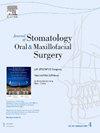牙周炎的范围、严重程度和发展速度与植牙失败之间没有关联。
IF 1.8
3区 医学
Q2 DENTISTRY, ORAL SURGERY & MEDICINE
Journal of Stomatology Oral and Maxillofacial Surgery
Pub Date : 2024-10-22
DOI:10.1016/j.jormas.2024.102123
引用次数: 0
摘要
目的:分析牙周炎的范围、严重程度和进展速度与种植效果之间的关系:分析牙周炎的范围、严重程度和进展速度与种植结果之间的关系:对 2011 年至 2022 年期间在 BigMouth 网络提供数据的大学牙科诊所就诊、寻求种植治疗的成年患者的牙科记录进行评估。根据 2017 年世界牙周和种植体周围疾病和条件分类研讨会的结果,进一步检查了患者的牙周诊断记录。根据范围(全身/局部)、严重程度(I、II、III、IV 期)和进展速度(A、B、C 级)对患者进行进一步分类。从患者的电子健康记录中提取的信息包括人口统计学特征、自我报告的医疗状况以及缺失牙齿的数量:筛选了 20842 名患者在 12 年间植入的 50312 个牙科植入体的记录。根据 2017 年牙周病分类,有记录的牙周炎诊断患者共植入了 322 个种植体。队列的平均年龄为(57.53±12.95)岁,其中男性占 52.2%,非西班牙裔占 74.2%,白人占 55.9%,糖尿病患者占 9%,吸烟者占 3.4%。单变量分析表明,牙周炎的范围、严重程度和发展速度与治疗结果无明显关联。种植失败率估计为 5.6%:这项回顾性研究利用了向 BigMouth 网络提供数据的美国机构的牙科植入记录,在研究的局限性范围内,植入失败率估计为 5.6%。牙周炎的范围、严重程度和发展速度与种植治疗的结果没有明显关联。本文章由计算机程序翻译,如有差异,请以英文原文为准。
No association between periodontitis extent, severity, and progression rate with dental implant failure
Objective
To analyze the relationship between extent, severity, and rate of progression of periodontitis with the implant outcome.
Methods
Dental records of adult patients who had attended the dental clinics of the universities contributing data to the BigMouth network between 2011 and 2022 seeking implant therapy were evaluated. Patients' records were furthered examined for a periodontal diagnosis based on the 2017 World Workshop on the Classification of Periodontal and Peri-Implant Diseases and Conditions. Patients were further categorized based on extent (generalized/localized), severity (stage I, II, III, IV), and rate of progression (grade A, B, C). Information including demographic characteristics, self-reported medical conditions, as well as the number of missing teeth were extracted from patients' electronic health records.
Results
Records of 50,312 dental implants placed in 20,842 patients over a 12-year period were screened. Three hundred twenty-two records of implants were placed in patients with a recorded periodontitis diagnosis based on the 2017 periodontal classification. The mean age of the cohort was 57.53±12.95 years which consisted of 52.2 % males, 74.2 % non-Hispanic, 55.9 % white individuals, 9 % diabetics, 3.4 % tobacco users. The univariate analysis demonstrated that periodontitis extent, severity, and rate of progression were not significantly associated with the treatment outcome. The implant failure rate was estimated to be 5.6 %.
Conclusions
Within the limitations of this retrospective study that utilized records of dental implants placed in institutions in the United States contributing data to the BigMouth network, the implant failure rate was estimated to be 5.6 %. Periodontitis extent, severity, and rate of progression were not significantly associated with the implant treatment outcome.
求助全文
通过发布文献求助,成功后即可免费获取论文全文。
去求助
来源期刊

Journal of Stomatology Oral and Maxillofacial Surgery
Surgery, Dentistry, Oral Surgery and Medicine, Otorhinolaryngology and Facial Plastic Surgery
CiteScore
2.30
自引率
9.10%
发文量
0
审稿时长
23 days
 求助内容:
求助内容: 应助结果提醒方式:
应助结果提醒方式:


